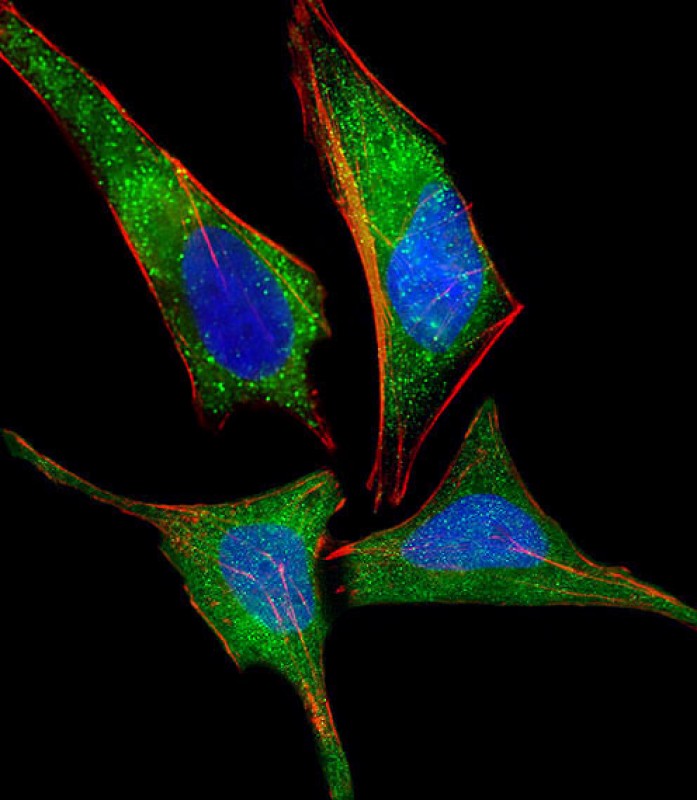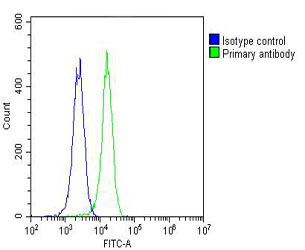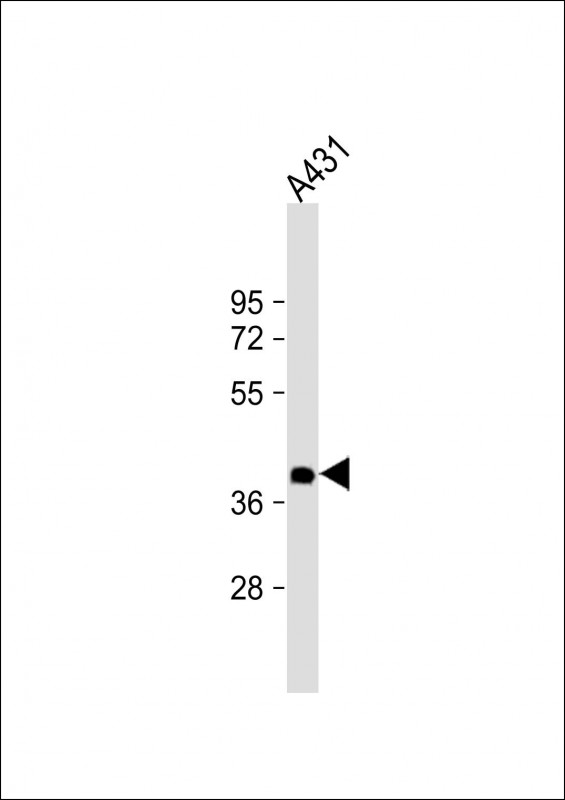NMI Antibody
Purified Mouse Monoclonal Antibody (Mab)
- 产品详情
- 实验流程
- 背景知识
Application
| WB, FC, IF, E |
|---|---|
| Primary Accession | Q13287 |
| Reactivity | Human, Mouse |
| Host | Mouse |
| Clonality | monoclonal |
| Isotype | IgG1,k |
| Clone Names | 1580CT730.43.59 |
| Calculated MW | 35057 Da |
| Gene ID | 9111 |
|---|---|
| Other Names | N-myc-interactor, Nmi, N-myc and STAT interactor, NMI |
| Target/Specificity | This NMI antibody is generated from a mouse immunized with a recombinant protein of human NMI. |
| Dilution | WB~~1:2000 FC~~1:25 IF~~1:25 E~~Use at an assay dependent concentration. |
| Format | Purified monoclonal antibody supplied in PBS with 0.09% (W/V) sodium azide. This antibody is purified through a protein G column, followed by dialysis against PBS. |
| Storage | Maintain refrigerated at 2-8°C for up to 2 weeks. For long term storage store at -20°C in small aliquots to prevent freeze-thaw cycles. |
| Precautions | NMI Antibody is for research use only and not for use in diagnostic or therapeutic procedures. |
| Name | NMI (HGNC:7854) |
|---|---|
| Function | Acts as a signaling pathway regulator involved in innate immune system response (PubMed:26342464, PubMed:29038465, PubMed:29350881, PubMed:9989503). In response to interleukin 2/IL2 and interferon IFN-gamma/IFNG, interacts with signal transducer and activator of transcription/STAT which activate the transcription of downstream genes involved in a multitude of signals for development and homeostasis (PubMed:29377960, PubMed:9989503). Enhances the recruitment of CBP/p300 coactivators to STAT1 and STAT5, resulting in increased STAT1- and STAT5-dependent transcription (PubMed:9989503). In response to interferon IFN-alpha, associates in a complex with signaling pathway regulator IFI35 to regulate immune response; the complex formation prevents proteasome-mediated degradation of IFI35 (PubMed:10779520, PubMed:10950963). In complex with IFI35, inhibits virus-triggered type I IFN-beta production when ubiquitinated by ubiquitin-protein ligase TRIM21 (PubMed:26342464). In complex with IFI35, negatively regulates nuclear factor NF-kappa-B signaling by inhibiting the nuclear translocation, activation and transcription of NF-kappa-B subunit p65/RELA, resulting in the inhibition of endothelial cell proliferation, migration and re-endothelialization of injured arteries (PubMed:29350881). Negatively regulates virus-triggered type I interferon/IFN production by inducing proteosome-dependent degradation of IRF7, a transcriptional regulator of type I IFN, thereby interfering with cellular antiviral responses (By similarity). Beside its role as an intracellular signaling pathway regulator, also functions extracellularly as damage-associated molecular patterns (DAMPs) to promote inflammation, when actively released by macrophage to the extracellular space during cell injury or pathogen invasion (PubMed:29038465). Macrophage-secreted NMI activates NF-kappa-B signaling in adjacent macrophages through Toll-like receptor 4/TLR4 binding and activation, thereby inducing NF-kappa-B translocation from the cytoplasm into the nucleus which promotes the release of pro- inflammatory cytokines (PubMed:29038465). |
| Cellular Location | Cytoplasm. Nucleus. Secreted Note=Cytoplasmic NMI localizes in punctate granular structures (PubMed:10950963, PubMed:9781816). Nuclear localization increased following IFN-alpha treatment (PubMed:10950963, PubMed:9781816) Extracelullar following secretion by macrophage (PubMed:29038465) |
| Tissue Location | Expressed in adult spleen, liver, and kidney (PubMed:9781816). Expressed in fetal thymus, liver, placenta, spleen, lung, and kidney but not brain (PubMed:9781816). Expressed in macrophages (PubMed:29038465). |
For Research Use Only. Not For Use In Diagnostic Procedures.
Provided below are standard protocols that you may find useful for product applications.
BACKGROUND
May be involved in augmenting coactivator protein recruitment to a group of sequence-specific transcription factors. Augments cytokine-mediated STAT transcription. Enhances CBP/p300 coactivator protein recruitment to STAT1 and STAT5.
REFERENCES
Bao J.,et al.Oncogene 12:2171-2176(1996).
Goshima N.,et al.Nat. Methods 5:1011-1017(2008).
Hillier L.W.,et al.Nature 434:724-731(2005).
Mural R.J.,et al.Submitted (SEP-2005) to the EMBL/GenBank/DDBJ databases.
Zhu M.-H.,et al.Cell 96:121-130(1999).
终于等到您。ABCEPTA(百远生物)抗体产品。
点击下方“我要评价 ”按钮提交您的反馈信息,您的反馈和评价是我们最宝贵的财富之一,
我们将在1-3个工作日内处理您的反馈信息。
如有疑问,联系:0512-88856768 tech-china@abcepta.com.























 癌症的基本特征包括细胞增殖、血管生成、迁移、凋亡逃避机制和细胞永生等。找到癌症发生过程中这些通路的关键标记物和对应的抗体用于检测至关重要。
癌症的基本特征包括细胞增殖、血管生成、迁移、凋亡逃避机制和细胞永生等。找到癌症发生过程中这些通路的关键标记物和对应的抗体用于检测至关重要。 为您推荐一个泛素化位点预测神器——泛素化分析工具,可以为您的蛋白的泛素化位点作出预测和评分。
为您推荐一个泛素化位点预测神器——泛素化分析工具,可以为您的蛋白的泛素化位点作出预测和评分。 细胞自噬受体图形绘图工具为你的蛋白的细胞受体结合位点作出预测和评分,识别结合到自噬通路中的蛋白是非常重要的,便于让我们理解自噬在正常生理、病理过程中的作用,如发育、细胞分化、神经退化性疾病、压力条件下、感染和癌症。
细胞自噬受体图形绘图工具为你的蛋白的细胞受体结合位点作出预测和评分,识别结合到自噬通路中的蛋白是非常重要的,便于让我们理解自噬在正常生理、病理过程中的作用,如发育、细胞分化、神经退化性疾病、压力条件下、感染和癌症。








